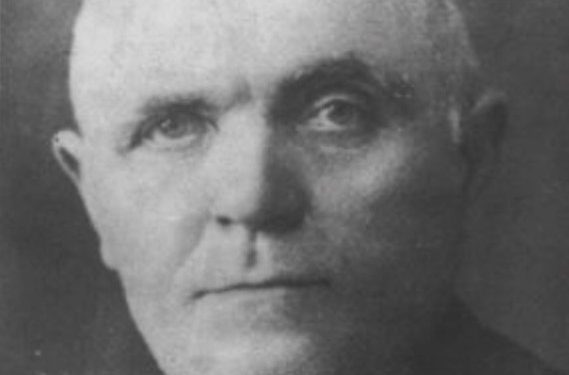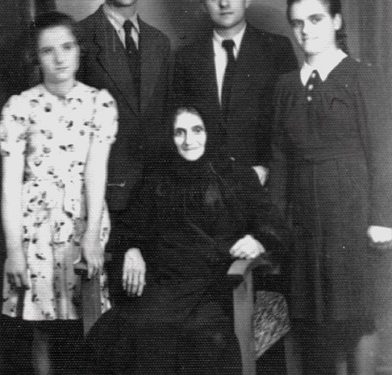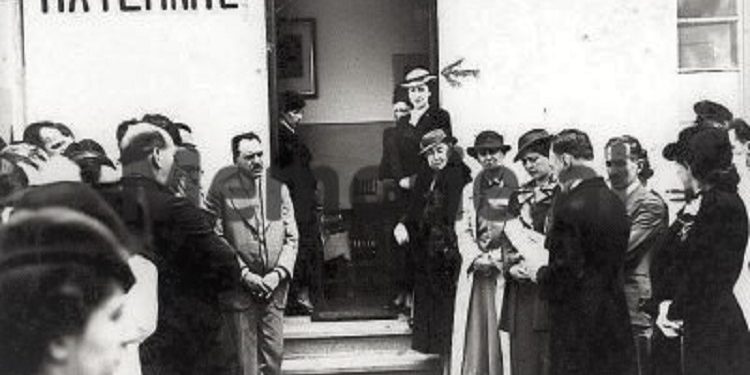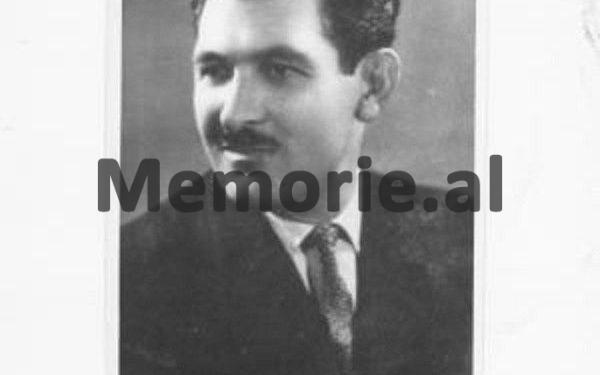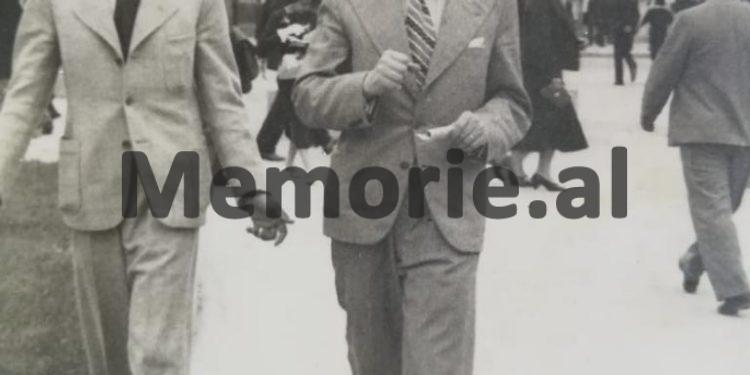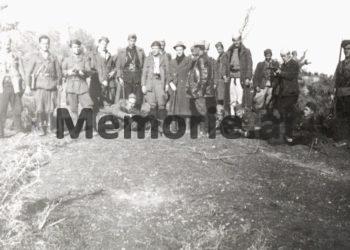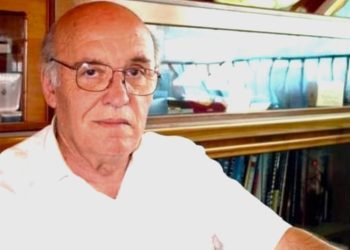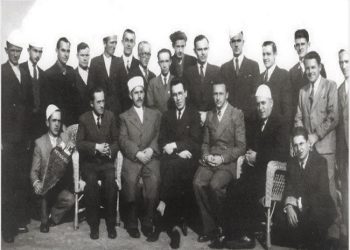By Koço Sterjo
The first part
CANNIBALIADA AND A TRIBUTE TO MOTHER IFI (HARITO) DILO
(An article, especially for the new generation of Albania)
Memorie.al / Kanibaliada. It started with the eating of the right to stay in Tirana, right after the end of the Second World War; it seemed to end with the slaughter of a mother at the doorstep and continues with the eating of the right to restitution. – Dilenjto – Haritenj. Some say the plural of their surname Dilaj, others Dilej, but I like it that way, because it seems to me that it expresses their greatness and greatness better. The other surname, Haritenj, would deserve the same treatment; – History of raids, raids and imprisonments. – What you will read below in this article is much more terrible than what you can imagine…!
THE ROOTS OF “CANNIBALIA”
The cannibalism towards the Great Family of Dilenj in Albania has its roots since its first, Professor Ilia Dilo Sheperi, at the beginning of the 20th Century, was the teacher of the future dictator of communist Albania and his son, Jani Dilo, was fellow student with him. Ever since then, when the zero grade would not be justified by Enver Hoxha, since, according to his usual deception about books, years later, he had completed the assignments from the bottom of the notebook and, thus, the Professor had not noticed, the mind of his paranoid, as if it were in complete synchronicity with the Hitlerian one, would project the darkest plans against the Albanian elite of the time.
With the fellow student, in addition to his failure to progress many times higher in his studies, in the years of the Second World War, their political paths would also be separated. On the other hand, in Albania, apart from popular philosophy; “Yours eats the meat, but keeps the bones”, seems to be the same as the other one; “Yours will take out your eyes”! They show that once, when the dictator asked the third lady of the country, who not only came from the same province as the Dilenjte, but with their branch of Nivan, had a close relationship from the Haritje, that; “What happens to the children of the Professor…”? – She answers: “All enemies, friend Enver”. (!) Are you saying that; the dictator needed such an ending!
The same thing with her brother, or what the great Albanian writer, Ismail Kadare, called “Party’s Loloja”, at that time the highest official of the Party in Elbasan, in the Metallurgical Combine “Party’s Steel”, where one of the youngest members of the Dilo family, Henriku, worked. When from the birthplace of both came the black fury of letters against Henrik, the highest official, instead of giving them a neutralizing note on the side, or, after all, with the authority that that high official gave him , to throw them in the basket, he did the next, worst thing, he threw the young boy in his hometown, to make him the closest prey to those who could not get enough of him, until they completely crippled him.
HENRY THE MARTYRIZED
Thus, Henrik Dilo, the son of Qirjako Dilo and the grandson of Ilia Dilo Sheperi, an intelligent boy, quite energetic, potential capacity for higher education, straight, from which he was hindered, master of his profession, electrician seventh category, although an imposed profession. Let’s recall here the chronicle of those years of this boy: Henriku, after finishing high school, since he was not given the right to continue his studies at the University, he went to Elbasan and worked as an asphalt worker in the Rruga-Ura company and in the mechanical office of this company, until he finished electrical high school to be able to work as a professional.
After finishing the vocational school, he worked as an electrician with the seventh category at the Metallurgical Combine “Celiku i Party” in Elbasan. Henrik was worthy to continue his higher studies, but this right was denied to him all his life. He became an electrician out of necessity to live, but even though he was a class sportsman, he would go through the ordeal of the next terrible suffering, ending up in the hands of those, where he should never have ended up, who would tear him apart. and then they would hand it over to the special bodies of the time (State Security), to put it through the intersection of primitive and contemporary ways of organized state crime, in such a way that the identity gene would disappear once and for all and, finally , they would put him in the dark cells of the prison.
The chronicle of time continues:
Henrik Dilo was fired and sent to the agricultural cooperative “Alqi Kondi” in the village of Nivan, to work as a cooperative in the agricultural forest. There he was not paid for his work and his days of work were not registered in the payroll and the “judge” of the province called him a parasite of society and ordered him to go to work in the Fushë – Bardhës mine, to separate him from his mother and family. Henry refused; then the State Security police started dealing with him, until they imprisoned him. They tortured him and the electroshock that was given to him in Tirana destroyed his health and ultimately ruined his life.
And where would they make the animal arrest?! Exactly, between his house and the bookstore. The latter, in fact, had also been their home, forcibly taken by the communist government and destined for a bookstore. In that nonsense, let’s make it halal that, at least, they intended it for a bookstore. And, precisely, in front of such an institution, now cultural, his arrest is carried out, from a hysterical mix-up between the various forces of the State Security and the Police. And not just an arrest with handcuffs, but with strong punches and kicks. And not just in front of the bookstore, as we said, but also in front of the house, in the eyes of his mother!.
“They gave me an electric shock,” says Riku, “They burned my genitals”! Doesn’t this torture surpass the Nazi methods against the Jews in the concentration camps, or the Serbian sterilization of Kosovars once…?! But, even this is a little something, before the irony of fate further on, precisely when the democratic explosions and changes occur. The former persecutors in Gjirokastër meet the victim as if nothing is wrong, as if they had not caused all those irreparable pains and kiss him on the cheek.
And this one does not react to oppose you, partly thanks to the education and the human culture from which it comes, partly thanks to the education and culture, which naturally carries itself and partly thanks to the destruction that they had caused. But, not scary! Henrik Dilo was not afraid then, when the dictatorship was at the peak of its violence and, since the investigators, courts and prisons were not enough, it started with public unmasking’s in villages and city neighborhoods.
One winter day in 1978, just a few months after the public unmasking of Seve Koçi in Sheper, they organized a similar one in the same village, for Henrik’s uncle, Mihal Dilon, the son of the famous professor of the Albanian language. Without going into the details of that ominous event, we cannot leave without mentioning one detail, right there at the end of the event. The meeting went into frenzy, when slogans were thrown against the class enemy and the actions for the Albanian Labor Party were made. Everyone applauded, but no one. Well, this man could not escape the “watchful eye”, which saw him and said: “And you, why don’t you applaud…”?! And the brave and courageous boy replied: “Why should I applaud you?! Against my uncle…”?!
This was Henrik Dilo, one of the Albanian boys martyred by communism, an unheralded martyr of freedom and democracy. But how good Riku is! I am not extending into the infinity of his virtues, but I am singling out only one, who is a synthesizer. Riku, the only personal income, has the disability pension (disability from the electric chair), all of which he spends on the “paths” (sebepet e vaki) in the village. Don’t leave such things without mourning, from births, baptisms, engagements, marriages, deaths to sending the children of fellow villagers to school, etc. Now Riku is very sick. All this, as a consequence of the human tortures that took place under the barbaric communist regime of Enver Hoxha and his successor, Ramiz Alia.
THE SAD END OF AN ARCHITECT
The same fate as Henrik, more or less, would also befall his older brother, Pirro, appointed as an architect engineer, appointed first in Tropojo, then in the Cataracts of Degdisje, Sukth in Durrës, Gjirokastër and later bottom, in his hometown – Zagori. Can the young generations today imagine that the architect ends up designing ordinary buildings?! Here is what the chronicle of the time reminds us: Pirrua designed social-cultural buildings in the city of Bajram Curri: houses, schools, hospital centers, workshops and, for the needs of the district, he designed water supply, as in Kam – Tropojo, irrigation canals, highways, etc., constructions, all these, outside of his profession, when he was the head of the Design Office in the Tropojo District.
The appointment in Sukth was very forced, completely outside his profession.) But, this is nothing! Can it be imagined that, precisely he-the architect, who, if allowed, would have given beautiful architectural works to the homeland, ended up in Gjirokastër, slept in the concrete domes of the Pazar Neck, where he watched the heat during the summer and, to be torn by the ferocity of the cold during the winter, and to remain homeless for the rest of his life, to the point of being crippled?! But this is also a little before the end of it, the destruction in the homeland, not to make walls of buildings, but to make cubes of stone walls, from the stones taken from the tractor across the fields, or in the opening of new lands.
But even this is nothing before what awaited the two brothers, Henrik and Pirro. Both of them would work together from early morning until late at night and they would receive 0.07 working days each or, to put it differently, in the language of the economists of that time, 7 points. (One working day in the cooperative was equal to 100 points.). Having worked in this way for nearly a decade, when the day of the bankruptcy of the agricultural cooperatives came and the list of total work days came out, we learned that the total amount, for these two “former cooperatives”, reached a ridiculous figure; 245 working days and we heard from their mouths the drama they experienced a few years ago.
The annual average of a man’s working days in the cooperative was 280 such, while for women, it was 230 such, so these two men, workers like them, in ten years, had worked a little more than a woman and a little less than a man, in the space of a year, both together, for a decade.) But this is not a thing before what comes after. They were given the task at dawn, to dig a big pit at the end of the sheep stalls to collect manure and cattle urine. In the evening it was said that; “We didn’t tell them here, but there, so tomorrow you will close this one and open the other one”. The same course and with the cubes of stones of the tractor. “We didn’t tell them here, but there. Tomorrow you will destroy them and drive them there”.
Those cubes, which Pirro erected as if he were erecting a palace and not as if they were paving stones that the next day they could be taken by people, to sit here and there, or by shepherds, for the grains of salt cattle. A lot of them, they could be made into brick walls. An entire army of cadres passed through the hands of the border guards. A whole community of compatriots watched them where and how they worked. But, everyone was silent and agreed with the situation. It got to the point where the little children were scared and they said: “We don’t cross the road under the house of the snipers, because we are afraid”!
THE EXCAVATION OF A HOUSE AND ITS REBUILDING
Whoever passes by one of the ordinary houses of the Harites in Nivan today, from my generation or the one before or after me, will be surprised when he sees a magnificent house, built on the foundations of the former, which were not visible from the covering with mud. Built by a single man. From him and a typical mason of those parts. A rare heroism, which bears the name of the architect engineer, already over 70 years old and in a very serious health condition, Pirro Dilo. The above-mentioned generations have in their memory just a ruin, almost covered by soil.
But the generations before them have in mind a high saraj there, a two-story one, which, if we add the sixth floor, becomes three. One dark day of the wild times of the communist period, the “Red Commissioner” (read: Black) would come there, with a team of vandals, and they would start throwing stones and tearing down the walls completely, to a few days later, the tractor arrived, which would do the final leveling of the building, leaving only a part of its facade. Yes, can houses be destroyed…?!
And, a bit worse, can works of art be damaged…?! That house, it was a work of art; it was a Cultural Monument, which, instead of being protected by the state, was being destroyed by its receiver. This house was one of the houses of the Haritenj, next to the other, where they lived in those years and where they currently live, Dilenjto – Haritenj. (On the walls of this last, unrestrained communist revolutionaries, how many nights would they spend, crawling like spiders?!)
While their base house, the one where Mihal and Petro Harito were born and died, where the Lady of these houses, who we are talking about in this article, was born, it was a miracle in itself, an architectural magnificence, not only for the time the first, but which even today’s buildings would envy, elegantly raised above the famous Gurra of Nivan, which, for me, is the only magical place at the tourist level, in that rare natural basin. I didn’t have the luck to see that house, which, if it existed today, would resemble a real tourist hotel complex, just like an airplane, raised for flight over the Nivan Stone.
And why didn’t I have that luck? Because the destructive communism had flattened it completely, before I grew up. How he destroyed everything national in our lands, in the name of “the cloud”. (This house is the one, under the shelters of which the infamous Albanian Security would hide weapons, to later accuse her son-in-law, Qirjako Dilon, and subject him to their bloodthirsty methods.) The master of the house, Qirjako, appears. Dilo, the son of the respected Professor of Albanian Grammar, the father of Antigoni, Pirros and Riku e, says to the Party Commissioner: “What did you do with the building, why are you tearing it down”?!
He answers with the viper’s tongue: “How, mother, how can we leave behind such a building?! What should we say to the delegates from Tirana, when they tell us that; whose house is that…”?! So, this was the reason why that house was falling apart! Meanwhile, father and son were sitting close to each other’s arms and shoulders. When he saw them like that, the commissar noticed and began to vomit bile, saying to Pyrrhus:
“What about you, brother, why do you put your hand on the shoulder of that enemy?” there are words to describe this plague! Precisely, that house physically rotted in the ground, Pirro Dilo, this hero of two times, of yesterday’s attitude and today’s patience and tirelessness, would bring it to light with nails and teeth.
Only with nails, with the power of the skeletons of his crippled body, work that took a lot of time, but that, above all, has really eaten tens of years of his life. Hundreds of cubic meters and displaced and tens of cubic meters of stone arranged for beauty and classified in several subdivisions, according to size and according to the purpose of use.
Of course, the building cannot come in the former parameters, of a classic construction, as it was in those times, due to the insufficient material and financial means of the concrete situation in question, but add to it the project of the engineer and the concern of his work, they tell me that a very beautiful house has turned out and it will become more beautiful in the future. But, its greatest beauty lies in the rise on the foundations of the first and the elevation of the so-called, as well as in the challenge, which made the dictatorial collapse of the past. Estimate, then, what optimism this man has! On the verge of 75 and without an heir, all alone, he works like a young man and builds new houses! Memorie.al.
USA, 2013
The next issue follows





